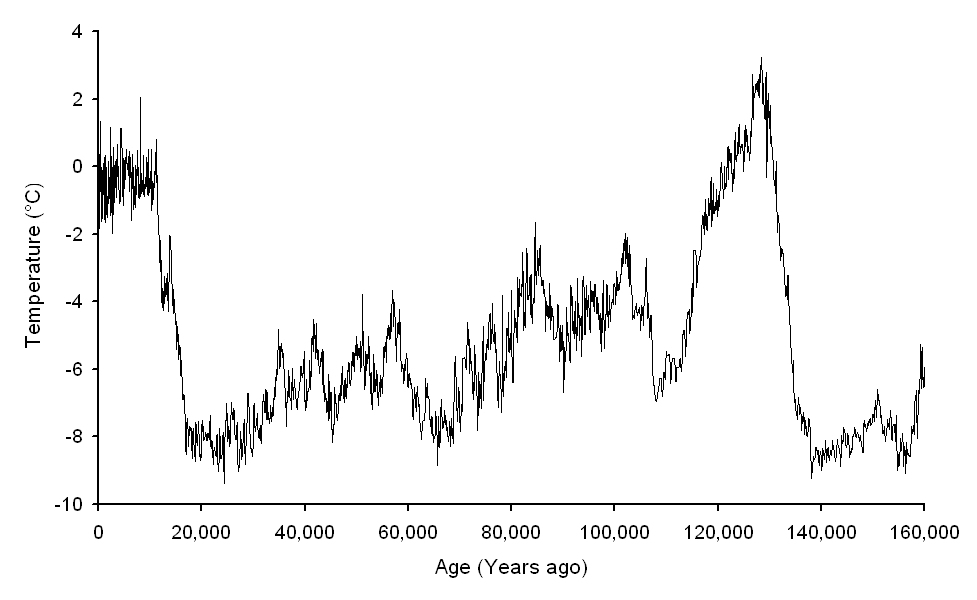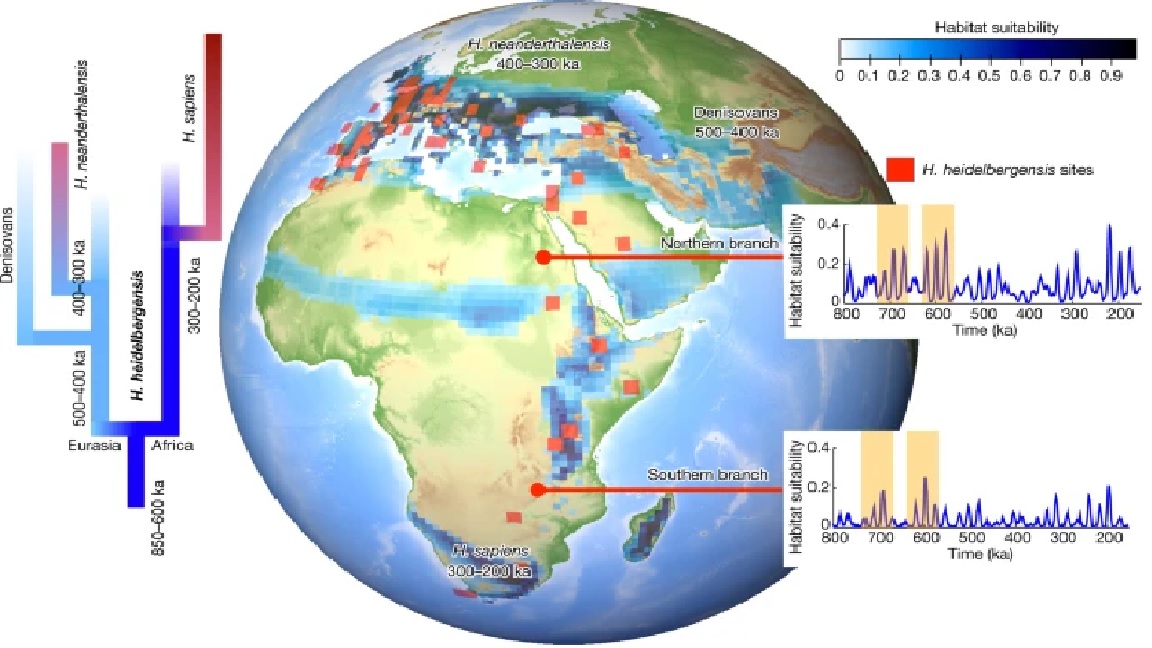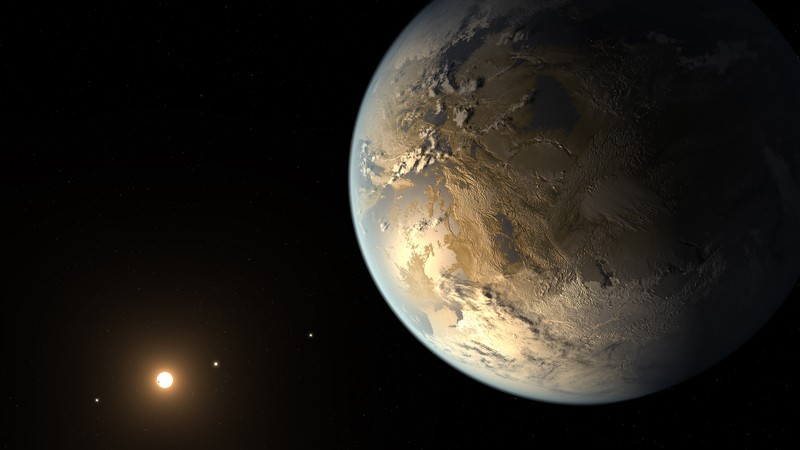Science
When did the first human evolve?
A SETI approach illuminates.
We do not have a fossil of the first human to evolve
and so it has been something of a mystery as to when
and where it happened. Now, a new approach – coincidentally
one used by astrobiologists to determine planets that might
harbour life – provides a firm indication.
Jonathan Cowie reports on the recent science.
Up to know, most of our understanding of the evolution of archaic human species, leading up to anatomically modern humans, has relied on fossils. However, we have never found the fossil of the very first modern human (Homo sapiens) ever to evolve. Indeed, even if we found a really old fossil – the oldest to date – there would always be the possibility of there being an even earlier fossil out there waiting to be found. (For the scientifically curious, this is known as the Signor–Lipps effect.) So, what to do?
Recently (2022), Axel Timmermann and his team came up with a new approach.(1.) It was one that examined the changing pattern of environmental conditions across Africa and Eurasia over two million years and linking that with the ecological habitats frequented by various Homo species: Homo ergaster, Homo erectus, Homo heidelbergensis, Homo neanderthalensis and finally Homo sapiens.
If this sounds a little complicated – and certainly the climate and ecological modelling is not simple – then an easy way to consider the essence of what the researchers were doing is to think of it as akin to what astrobiologists do when they consider which exoplanets might harbour life. Here, quite simply, when considering planetary habitability astrobiologists look for exoplanets that might retain an atmosphere and be appropriately distanced from their star (be in the habitable zone) so that liquid water might exist on its surface: they seek planets whose environmental conditions are suitable for complex (multicellular) life. This methodology is used to identify exoplanets that are 'Earth-like' and could harbour life and so could be dubbed 'Earth 2'.
This potential habitat approach is exactly what the Axel Timmermann team did, only they looked at Africa and Eurasia (not entire exoplanets and their location from their star) and instead of the environmental conditions suitable for life itself, they looked at the specific environmental and ecological conditions suitable for various archaic species of human within the continents of Africa and Asia. They were trying to find locations and times (due to natural climate change) most favourable for humans.
Fortunately, we know from where fossils of archaic humans were found, and their dating, the environmental conditions in terms of other species also present at the time the archaic human was alive. Further, the past four decades, with the advances in climate modelling fuelled by global warming concerns, we can now model past climate change in a fair bit of detail including in the middle of glacials (the cold parts of an ice age). In addition, climate change science has advanced so much that we have a detailed picture as to how the global climate, as well as regional climates, have changed the past two million years. (There is much hard climate evidence from: Greenland and Antarctic ice cores, isotopes from cave limestone, lake sediment pollen analysis, marine foram sediments and so forth.) Further still, knowing local geography, we can use local climate conditions to determine local biology. In short, we can marry the climate and ecological conditions in which various human species thrived and see how these conditions changed over time.

160,000 years worth of climate as revealed by Antarctic deuterium cores.
These broadly – though not exactly – chime with similar from Greenland.
Tropical temperatures follow this path but in a milder, less extreme, way.
Graph compiled by the author using data from the US National Oceanic
and Atmospheric Administration.
Picture from Cowie, J. (2007) Climate Change: Biological and human
aspects. Cambridge University Press, Cambridge.
Using one of South Korea's fastest science supercomputers named Aleph, the Institute Centre for Climate Physics/Institute for Basic Science, Cray XC50-LC supercomputer, the Axel Timmermann team were able to model past climates at 'local' levels. Having established ecological conditions for locations across Africa and Eurasia to a resolution of 1° latitude and longitude, it is possible to see where each individual species of archaic and modern human could, in theory, live. Here, not only are there tracts where more than one species might thrive, but also areas where just one species of archaic human might thrive.
Finally, when considering a species 'a' evolving into species 'b' it is important that this happens in just those places and times where both species can survive. This overlap needs to last between several, if not scores of, centuries.
Pulling all this together, it is possible to see roughly where and when the first members of each species of human evolved and potential avenues of subsequent migration.
The picture the researchers arrive at suggests evolutionary transitions from one species of human to another taking place earlier than the oldest fossil we have so far found of most archaic species. This picture also chimes with something else: genetic evidence.
Obviously, we have considerable genetic information relating to present-day humans but in addition we have genetic evidence of humans thousands of years ago and even of Neanderthals many thousands of years ago.
Here, the thing is that genes mutate with time so that the greater the genetic difference of corresponding genes implies a greater time period. In this way, we have genetic clock evidence as to the likely evolutionary connections and inferred evolutionary timings between Denisovan and Neanderthals and well as modern humans and Neanderthals. These timings chime with the picture the Axel Timmermann team have developed.
The scenario they have developed is as follows. About 850 to 600 thousand years ago, H. heidelbergensis (which may well have originated from H. ergaster in eastern Africa) split into southern and northern African branches, the latter of which included northern African and Eurasian populations. The southern branch experienced considerable climatic stress in southern Africa which could have accelerated evolution into H. sapiens. The Eurasian populations of the northern branch of H. heidelbergensis further evolved around 430 thousand years ago, possibly giving rise to Denisovans, which populated parts of central and eastern Asia.
Inside central Europe, H. heidelbergensis, gradually evolved into H. neanderthalensis between 400 and 300 thousand years ago. Modern humans, they conclude, first evolved 310 to 200 thousand years ago in what is today South Africa and then over thousands of years migrated up the African Rift valley before crossing into Eurasia where in Europe they encountered Neanderthals.
A pictorial representation of when and where all this may have happened is given in the figure below which is taken from the Axel Timmermann research paper.

A pictorial summary of the when and where of human evolution.
Blue areas represent early human species' habitat suitability.
© Timmermann, A., Yun, K-S., Raia, P. et al. (2022) Climate effects on archaic
human habitats and species successions. Nature, vol. 604, p495-501
used non-commercially in the context of a review.
The following year (2023) the Axel Timmermann research team – this time with Elke Zeller as the lead author – published some follow-up work.(2.) Again using Aleph and refining their models, they found a new trend… But first, some background information.
Biomes are regional level ensembles of ecosystems. For example, a woodland biome – such as the oak/ash biome that used to cover much of ancient, pre-human England – is not just a landscape of endless trees. There will be places where a large old tree has fallen over knocking down other trees and creating a clearing letting in sunlight. There will be hollows that contain ponds. There will be streams and rivers flowing through them. Each of these provide different ecosystems: a pond ecosystem will be different and have different species as to, say, the more general woodland ecosystem. In short, a biome is a mosaic of different ecosystems.
Similarly, at the larger scale, biomes themselves can become patchwork. While today, the Amazon has a vast tract of tropical rain forest (sadly in too many places now being denuded by humans), to its south there is bordering a patchwork of forest and grassland. So at the biome level, there too can be mosaic environments.
Now, what the Elke Zeller research found was that as humanity evolved through different archaic human species to H. sapiens, in Africa and then later in Europe and Asia, so the environments they inhabited became more fractured, more mosaic. They found a significant clustering of early human occupation sites in regions with increased landscape diversity: our human ancestors had a liking for mosaic landscapes, with a greater variety of plant and animal resources nearby. Moving into Eurasia around 1.8 million years ago, archaic human species, such as H. erectus and later H. heidelbergensis and H. neanderthalensis developed higher tolerances to other biomes over time, including temperate and boreal (sub-Arctic) forests.
This suggests that to survive, these more advanced species had to be more mobile and develop new abilities, including social co-operative skills, and this necessitated greater intelligence. Eventually, H. sapiens evolved around 200,000 years ago in Africa, quickly becoming the master of all trades. Flexible, mobile and so competitive, our immediate H. sapiens ancestors, unlike other Homo species before, could survive in harsh environments such as deserts and tundra. Indeed today, members of our species can survive for many months in a totally new environment, off planet in space!
There are still plenty of unknowns and detail of this area of human evolutionary and environmental science to fill in, but this latest science does provide a framework for human evolution that chimes with both archaeological finds and genetic evidence. This is a significant stride forward into the understanding of our origins.
However, as always, further research would be revealing. Refining their climate-to-local-environmental-and-ecological models, and developing ones with a higher resolution, might shift the early end of habit suitability as well as constrain where the evolutionary transition from one species of human to another took place. It should even be possible to eventually constrain these places to within a few river catchments: perhaps even narrower still? In short, we will be able to tell anthropologists where to look for fossils. This may even happen sooner than some may think, possibly within the next decade or two. Whether or not this happens before we detect bio-signatures of life from a planet in another star's habitable zone remains to be seen…
Jonathan Cowie
References
1. Timmermann, A., Yun, K-S., Raia, P. et al. (2022) Climate effects on archaic human
habitats and species successions. Nature, vol. 604, p495-501.
2. Zeller, E., Timmermann, A., Yun, K-S. et al. (2023) Human adaptation to diverse biomes
over the past 3 million years. Science, vol. 380, p604-608.
[Up: Article Index | Home Page: Science Fact & Fiction Concatenation | Recent Site Additions]
[Most recent Seasonal Science Fiction News]
[Convention Reviews Index | Top Science Fiction Films | Science Fiction Books]
[Science Fiction Non-Fiction & Popular Science Books]
